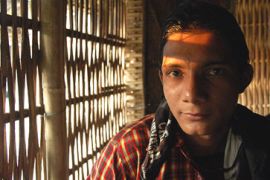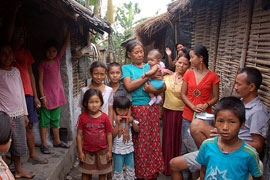Lhotsampa leave Nepal refugee camps
Tens of thousands are looking for resettlement in the West.

 |
| The Lhotsampa say they are divided on resettlement in the West as a viable option [OSBERG] |
Dhan Bahadur Giri and his extended family are here to say good-bye.
Like hundreds of others they are standing under the drizzling grey rain at Beldangi II refugee camp in Eastern Nepal. His cousin’s bag is among the dozens being hefted up into the roof-rack of a bus parked on the dirt road.
“Nineteen years here is enough,” says Giri. “It’s time for them to go and do something in life.”
Giri, his family, and some 100,000 other Bhutanese have lived in bamboo huts on the Terai plains of eastern Nepal since the early 1990s, when they say they were ‘ethnically cleansed’ from Bhutan.
Another of the seven refugee camps in the region is Timai, where Hari Maya Gurung is crouching on a dirt floor, arranging the few pots and pans that distinguish this room as her kitchen.
Her family used to own 15 acres of land in the village of Leopani in southern Bhutan, where they tended three orange orchards and raised cows and oxen. Today all that she possesses can be found within this small hut.
Gurung’s great-great-grandfather was among thousands of Nepalese to emigrate to Bhutan a century ago, building farms in the inhospitable southern reaches of that country.
The Gurungs and their ilk – called ‘Lhotsampa’ in Bhutan – were mostly Hindu and comprised the peasant class in a country that was predominantly Buddhist. Bhutan’s rulers largely ignored the Lhotsampa until the later half of the 1900s when the government became nervous of their rapidly growing population and increasing political clout.
In 1985, the government passed a law stripping most Lhotsampa of their citizenship, effectively initiating a campaign to dislocate them from the land.
Categorised as “terrorists”
Gurung says the problems for her family started in the mid-1980s when the police in her village began “verifying” citizenship. Unable to produce the required paperwork, she says all nine of her children were categorised as “terrorists” by the Bhutanese state.
“It was agony,” says Gurung, recalling how she pleaded with the authorities for leniency.
Refugees have always accused the army of setting up barracks throughout southern Bhutan and demolishing their homes. They have also accused the military of arresting, torturing, raping and murdering people from their community.
The Bhutanese government has denied accusations that it ethnically cleansed the Lhotsampa from Bhutan.
Nevertheless, Gurung remembers the night government officials knocked on her door.
“Nepal is your country” she says they told her. “Leave Bhutan. If we return and you are still here, we will lock you inside this house and burn it down.”
Gurung says the family fled the next morning, leaving behind everything and joining thousands of Lhotsampa already streaming west toward the border with India. In all, roughly one-sixth of Bhutan’s population left in this manner, with the exodus peeking between 1990 and 1993.
The Indian government denied them refuge but allowed them to transit through to Nepal.
Almost two decades later and Gurung is still here.
Growing up a refugee
 |
| A whole generation of Lhotsampa children have grown up as refugees in Nepal [OSBERG] |
For Lal Bdr Bhattarai, 21, Beldangi II refugee camp is the only home he has really ever known, as he was just a toddler when his parents fled their village.
Like most Lhotsampa, Bhattarai’s father had been taught to sow crops in the fields by the generation before him. Bhattarai’s education, however, has been in the classrooms of schools set up by the United Nations and other aid groups.
He has learned English, mathematics, geography and computer skills in the camp. However, he still does not quite know what to do with this education.
“We have no rights in Nepal. We can’t even work,” he says. Some refugees do work illegally as labourers in nearby towns, but earn as little as 50 Nepalese Rupees ($0.63) per day.
In reaching for a better life, Bhattarai’s best friend is in the midst of ‘cultural orientation’ sessions – a last step before he is to be resettled to Chicago.
Through the United Nations High Commission for Refugees (UNHCR), which runs the camps, and groups like the International Organisation for Migration (IOM), the first major departures of refugees began in March 2008, and to-date around 12,000 refugees have left.
Seeking another home
According to the United Nations High Commissioner for Refugees (UNHCR), some 66,000 others have expressed interest in being resettled. The US has agreed to take in at least 60,000 refugees, Canada and Australia are accepting 5,000 each and several other countries are offering resettlement for smaller numbers.
Bhattarai calls resettlement a great opportunity to begin a new life.
“We still love our country, but only in our minds – we may never go back,” he says.
But even while Bhattarai himself is seeking resettlement, his father is not – holding out hope that one day he will return to his home in Bhutan.
Many of the older generation doubt whether they could work in a western country and adapt to the culture. Their hopes of returning to Bhutan, however, have dwindled over the 15 years the governments of Nepal and Bhutan negotiated refugee repatriation; in the end not a single refugee was able to return home.
The Nepalese government has also never offered to nationalise the refugees, and so in the limbo of the camps the refugees’ lives began to stagnate.
Divided
 |
| Many of the younger generation have opted to seek opportunities in the West [OSBERG] |
When resettlement emerged as a viable possibility three years ago, it tore divisions through the refugee society.
Prajeet Rana, 24, says many of the older members of the community opposed resettlement, claiming that the only just and acceptable resolution to their situation is to return to Bhutan.
They maintained that their land was stolen from them and they must reclaim it.
“It was brother against brother,” says Rana. “They’d say ‘you are traitors, you are cowards, all that your fathers did in Bhutan was in vain’.”
He says riots ravaged the camps, homes were destroyed, several people were kidnapped and killed, and others forced to seek asylum outside the camp for their own safety.
But once the resettlements actually began and refugees started leaving, momentum shifted gradually toward acceptance. In the end, several of those leaders most vehemently opposed to resettlement were themselves resettled.
“I’ve experienced life for 18 years in this camp, and it is meaningless, and there is no chance to go back,” says Rana.
Even if he had the option was open to return to Bhutan, Rana says he would only go if the constitution there was changed to end ethnic discrimination.
“But this is never going to happen.”